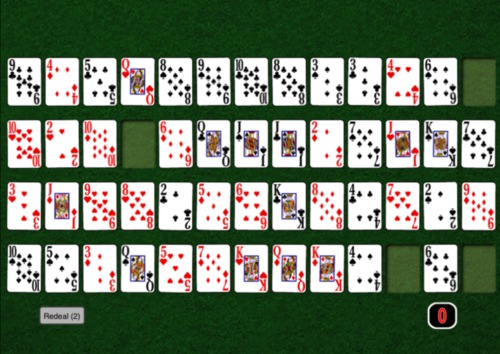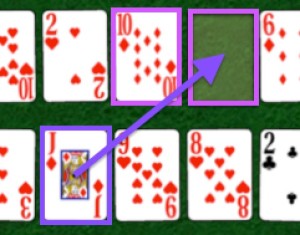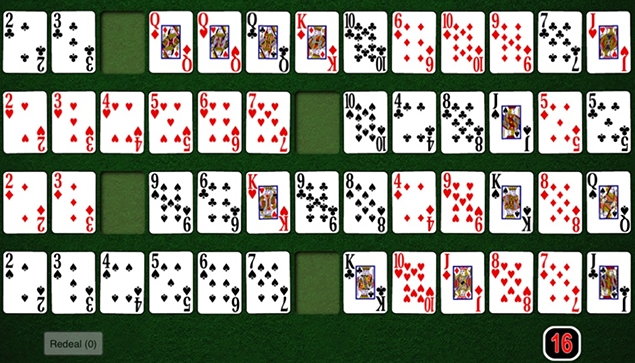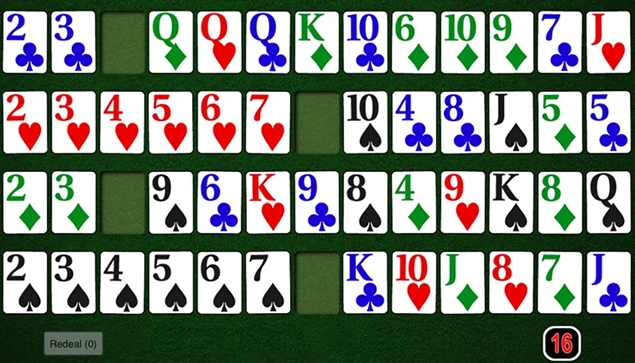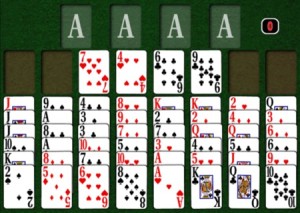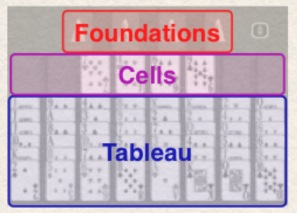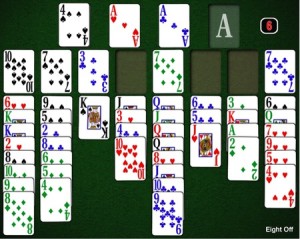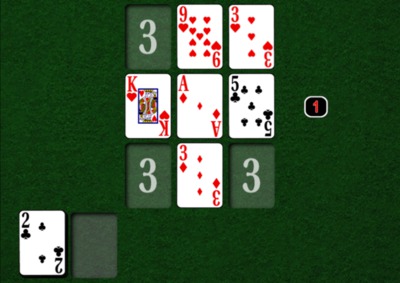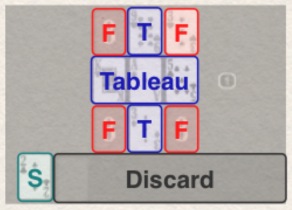Trefoil + Draw
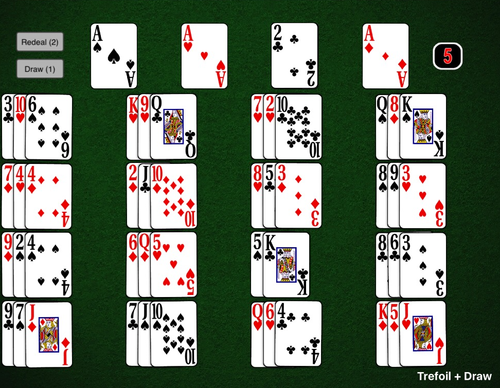 Trefoil + Draw is a classic “Fan” style game, challenging and winnable a lot of the time.
Trefoil + Draw is a classic “Fan” style game, challenging and winnable a lot of the time.
Trefoil + Draw is my favourite of all the Fan style games, and one of my top choices when I feel like a few quick games of solitaire, without having to worry about complex strategies using Cells, etc… This game is a slight variant on ‘Trefoil’, adding an opportunity to free up a blocked card one single time – I find this small concession very satisfying when you’ve played a good game and just been a little unlucky in the lay of the cards in the last deal.
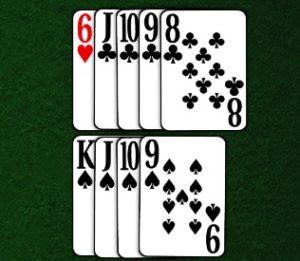 The rules are very simple – build the Foundations up in suit, and you can build the Tableau piles down in suit. Only one card at a time may be moved, and you can’t re-use spaces. The result of this, is that in for any deal you often get one or more cards that are immediately blocked. For example, any cards under a King, which can only be moved directly to Foundations. It also means that a card can only be moved once during a deal, as it only has one possible target it can be played on.
The rules are very simple – build the Foundations up in suit, and you can build the Tableau piles down in suit. Only one card at a time may be moved, and you can’t re-use spaces. The result of this, is that in for any deal you often get one or more cards that are immediately blocked. For example, any cards under a King, which can only be moved directly to Foundations. It also means that a card can only be moved once during a deal, as it only has one possible target it can be played on.
This game gives you several options to escape when the game is completely blocked…

Redeal:
You’re allowed 2 re-deals during the game, where any cards not on a Foundation pile are gathered, shuffled and re-dealt to the Tableau.
Draw:
As a last result, you have a single chance to pull any card out and put it on top of its pile – this can be extremely useful when the board is well set up, but one card is blocked. The best strategy tends to be to use the re-deals first, and save your Draw for the very last deal, when you’re totally stuck, and have no other options.
During each deal, after clearing cards that may be played immediately to Foundations, the next thing you should consider is what plays are “low hanging fruit”. Check the location of all the Kings, since there’s nothing you can do to move them, and immediately build on any that are at the top of their piles, since we know they can’t be moved by themselves except to Foundations, and the cards built on them are not going to prevent that. Next, check to see if there are any piles that contain only a single card – and build on them as much as you can next, since they won’t be blocking any other cards.
Once you’ve built all you can ‘for free’, you’ll need to examine the board and see which cards have a chance to be freed, and which ones will never be freed (i.e. under Kings or other blocked cards), build so that you can free up cards that might have a chance to go to Foundations, and ignore anything that will be stuck for this deal. You’ll often find that one move will block another move, so there’ll be tradeoffs to be made about which cards will be freed, and which can be blocked until the next deal.
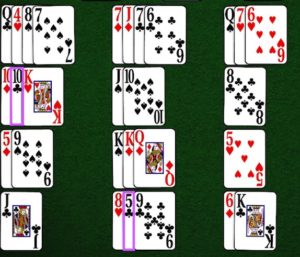
When you are finally stuck, and ready to execute the “Draw”, it’s worth considering lateral moves. Often the instinct is to free a card that can move straight to the Foundations, and this is often the right move, but occasionally there are other ways to use this. Take this example below for example. If we want free up all the cards we can in the Clubs suit, it’s tempting to pull the 5Clubs to the top of the pile, and play from there. This will enable us to play the 5, 6, 7, 8 and 9 of clubs. However, if instead of Drawing the 5Clubs, we Draw the 10Clubs, that will enable us to move the 9Clubs onto it, and free the 5Clubs that way, and we’ll be able to play the 5, 6, 7, 8, 9 , and 10 of Clubs, giving an advantage.
It’s often useful to use the 4-colour deck, as you can very quickly see the distribution of your suits across the Tableau
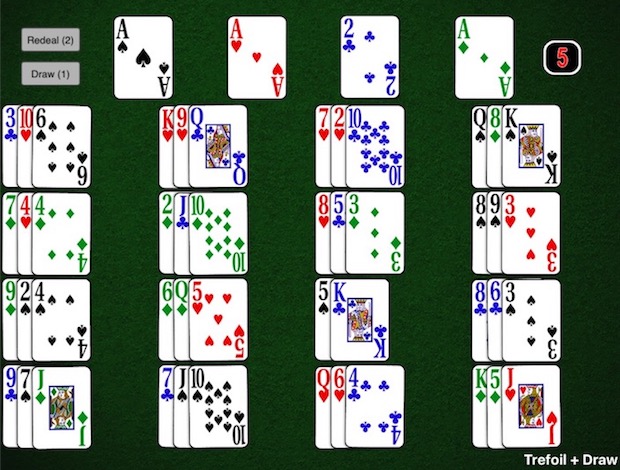 Using the Four Colour deck with Trefoil + Draw
Using the Four Colour deck with Trefoil + Draw
“Trefoil + Draw” is available now on Allgood Solitaire for OS X , and also in Allgood Solitaire for iPad.
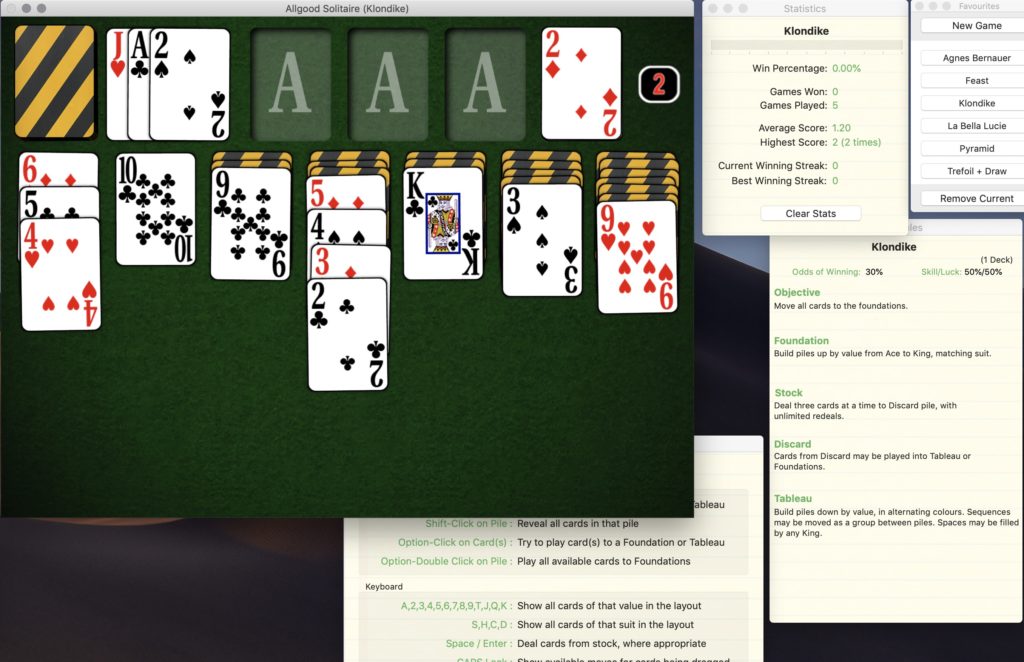
 Trefoil + Draw is a classic “Fan” style game, challenging and winnable a lot of the time.
Trefoil + Draw is a classic “Fan” style game, challenging and winnable a lot of the time. The rules are very simple – build the Foundations up in suit, and you can build the Tableau piles down in suit. Only one card at a time may be moved, and you can’t re-use spaces. The result of this, is that in for any deal you often get one or more cards that are immediately blocked. For example, any cards under a King, which can only be moved directly to Foundations. It also means that a card can only be moved once during a deal, as it only has one possible target it can be played on.
The rules are very simple – build the Foundations up in suit, and you can build the Tableau piles down in suit. Only one card at a time may be moved, and you can’t re-use spaces. The result of this, is that in for any deal you often get one or more cards that are immediately blocked. For example, any cards under a King, which can only be moved directly to Foundations. It also means that a card can only be moved once during a deal, as it only has one possible target it can be played on.

 Using the Four Colour deck with Trefoil + Draw
Using the Four Colour deck with Trefoil + Draw